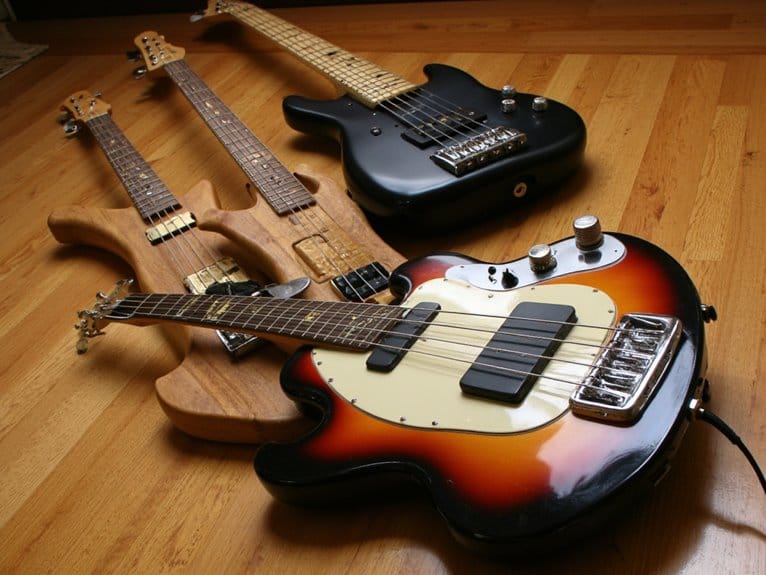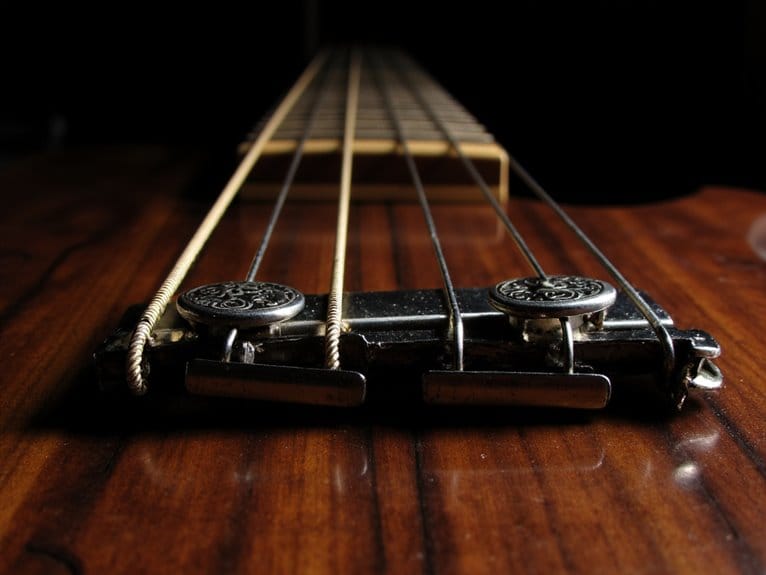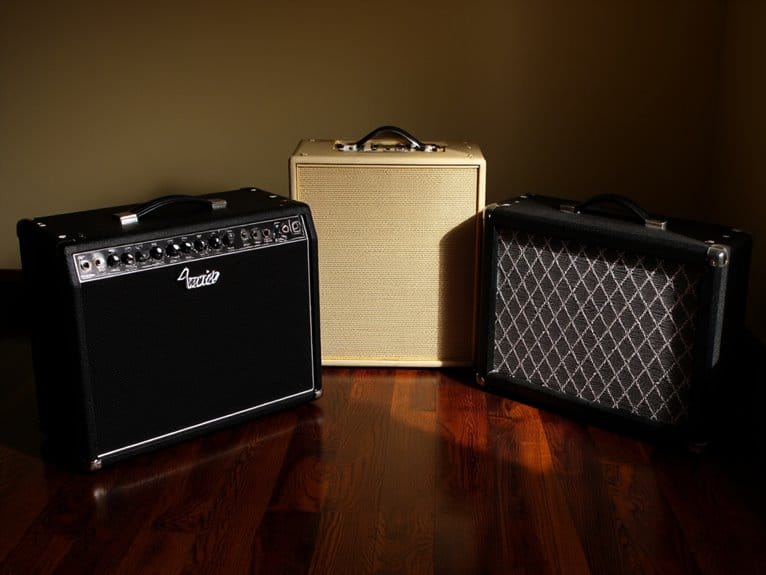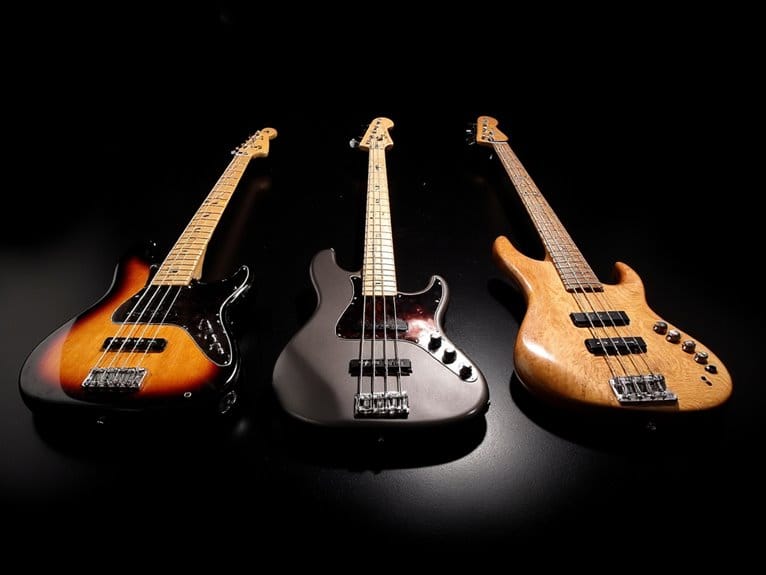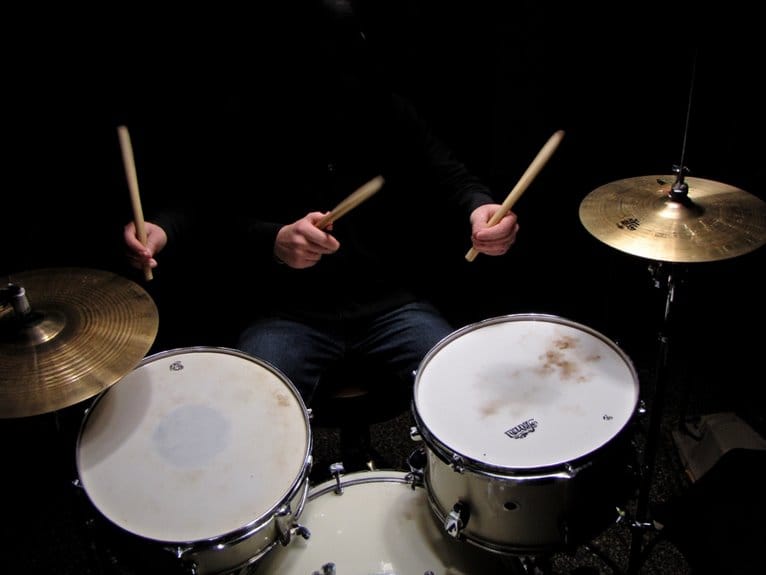4-String vs. 5-String vs. 6-String: Choosing Your Weapon
Your string count choice fundamentally shapes your musical possibilities: 4-string basses excel in rock, blues, and punk with their E-A-D-G tuning and easier playability, while 5-string configurations add that essential low B for metal, funk, and gospel applications. Six-string models incorporate both low B and high C strings, opening progressive rock and jazz fusion territories but requiring professional setup for proper tension balance. Each configuration brings distinct maintenance costs, technical requirements, and genre-specific advantages that’ll influence your long-term playing experience.
We are supported by our audience. When you purchase through links on our site, we may earn an affiliate commission, at no extra cost for you. Learn more.
Notable Insights
- 4-string basses offer the easiest playability and lowest cost, making them ideal for beginners and traditional rock/blues styles.
- 5-string configurations add low B extension for metal and modern genres while requiring careful setup for proper string tension balance.
- 6-string basses provide maximum tonal range with low B and high C, suited for progressive and jazz fusion players.
- String replacement costs increase significantly with more strings, with 5-string sets costing 25% more than 4-string alternatives.
- Genre requirements largely dictate optimal string count: 4-string for classic styles, 5-string for modern music, 6-string for experimental work.
Understanding the Range and Tonal Capabilities of Each Configuration
When you’re deciding between 4-, 5-, or 6-string configurations, understanding each instrument’s tonal range becomes essential for matching your musical goals with the right tool.
The traditional 4-string bass, with its E-A-D-G string tuning, covers fundamental bass frequencies that work perfectly for rock, blues, and classic funk styles.
The four-string bass delivers classic low-end fundamentals that define traditional rock, blues, and funk basslines with proven reliability.
Adding that low B string on a 5-string extends your range about one octave lower, creating smoother tonal shift into deeper territories favored by metal and modern pop genres.
The 6-string configuration adds both low B and high C strings, expanding your frequency spectrum at both ends for progressive styles requiring intricate melodic work. Modern velocity-sensitive pads in electronic drum modules capture these same dynamic variations that acoustic bassists achieve through different string configurations.
Each setup demands different string tensions and gauges, directly affecting your instrument’s harmonic content and sustain characteristics. The string manufacturers continuously emphasize how these material choices and construction methods influence the overall sound quality you’ll achieve. Switching between these configurations may require neck adjustments to accommodate the varying string tensions and maintain proper playability.
Extended range instruments like 6-string and 8-string basses offer expanded tonal capabilities for adventurous players ready to explore different musical dimensions, though they typically require intermediate skill levels to handle effectively.
Playability Factors and Technical Requirements
Beyond the tonal considerations we’ve covered, the physical demands of playing different string configurations present equally important factors that’ll directly impact your comfort, technique development, and overall playing experience.
Each configuration demands specific technical adjustments, from truss rod modifications to accommodate increased neck tension, to nut slot widening for thicker strings, particularly that low B string on 5- and 6-string models.
Here’s what you’ll encounter with each configuration:
- 4-string basses offer the easiest fingering changes and require minimal action adjustments for ideal playability.
- 5-string models demand careful gauge selection to balance that additional low B string’s tension against the other four.
- 6-string configurations require professional setup expertise to achieve uniform tension across all strings for comfortable fretting.
- String materials greatly influence playability-stainless steel provides enhanced grip control, while nickel offers smoother feel across wider fretboards.
Genre Suitability and Musical Applications
While technical specs and playability matter tremendously, I’ve found that your musical genre often dictates which bass configuration will serve you best, since each string count brings distinct tonal characteristics and range capabilities that align naturally with specific musical styles.
| Bass Type | Primary Genres |
|---|---|
| 4-String | Rock, blues, pop, country, punk |
| 5-String | Metal, funk, jazz, gospel, R&B |
| 6-String | Progressive rock, jazz fusion, experimental |
For genre exploration, four-string basses excel in traditional settings where straightforward rhythmic functions dominate, while five-string configurations reveal sub-bass frequencies essential for modern metal and funk applications. Six-string instruments enable artistic expression through chordal playing and melodic solos, particularly valuable in progressive and fusion contexts where extended range capabilities support complex harmonic structures and advanced techniques. The standard tuning for four-string basses (E-A-D-G) provides the foundation for mastering basic scales and traditional basslines across these versatile genres.
Budget and Maintenance Considerations
Your budget considerations extend far beyond the initial bass purchase, and I’ve learned through years of playing that ongoing string maintenance costs can greatly impact your wallet depending on which configuration you choose.
String maintenance costs accumulate significantly over time, often exceeding your initial bass investment if you don’t plan strategically from the start.
The price differences become evident quickly, with 5-string sets costing approximately 25% more than 4-string equivalents, while 6-string configurations push costs even higher due to additional strings and specialized materials.
Consider these long term investments when calculating total ownership costs:
- Initial string costs – 4-string sets offer the most economical entry point
- Replacement frequency – More strings mean proportionally higher cumulative expenses over time
- Coated string benefits – Higher upfront costs but extended lifespan reduces replacement intervals
- Material durability – Stainless steel and flatwound options provide better longevity despite premium pricing
String construction choices also affect your budget, as roundwound strings typically cost less than flatwound or half-round alternatives while delivering the bright, energetic sound preferred by many bassists.
On a final note
You’ve got the facts now, so trust your instincts when making this choice. Whether you’re gravitating toward a traditional 4-string for its simplicity, a versatile 5-string for extended range, or a 6-string for maximum tonal possibilities, there’s no wrong answer here. Consider your budget, musical goals, and physical comfort, but don’t overthink it-you’ll adapt to whichever configuration you choose with practice and patience.

